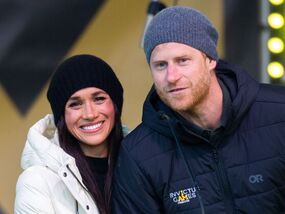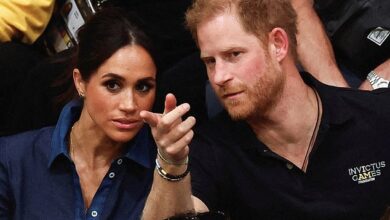Prince Philip called Meghan ‘DoW’ because she reminded him of the Duchess of Windsor… and the Queen thought her Givenchy wedding dress was ‘too white’ for a divorcee, writes INGRID SEWARD in her revelatory new book
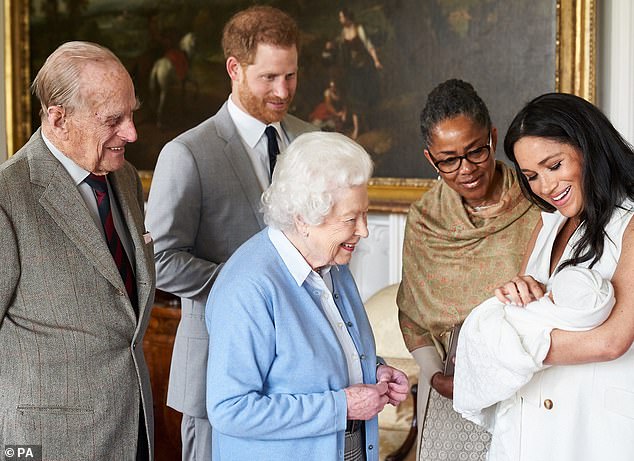
From their very first meeting, over tea at Buckingham Palace, the Queen approved of Meghan Markle. Not only did she like her, she had high hopes for what the American actress might be able to achieve with Harry for the youth of the Commonwealth.
Soon the country as a whole seemed to take to Meghan with equally genuine delight. One of the few wary of succumbing to her charm offensive, however, was Prince Philip. While the Queen continued to champion Harry’s new love, he warned his wife to be cautious. It was uncanny, he told her, how much Meghan reminded him of the Duchess of Windsor.
He wasn’t simply referring to the fact that both were pencil-slim, dark-haired and glamorous American divorcees. There was a wealth of subtext in his barbed remark.
When she was just ten, Princess Elizabeth’s beloved father had suddenly become King, after Edward VIII — later the Duke of Windsor — abdicated for the sake of marrying Wallis Simpson, an American divorcee.
This caused a permanent rift in the royal family: the new King George VI refused to receive her and denied her the appellation of Her Royal Highness. For her part, the American duchess openly mocked the Queen (later Queen Mother) as ‘the fat Scotch cook’.

The Queen and Prince Philip meet their new great-grandchild, Archie, held by Meghan (right). Harry and Meghan’s mother Doria watch on proudly
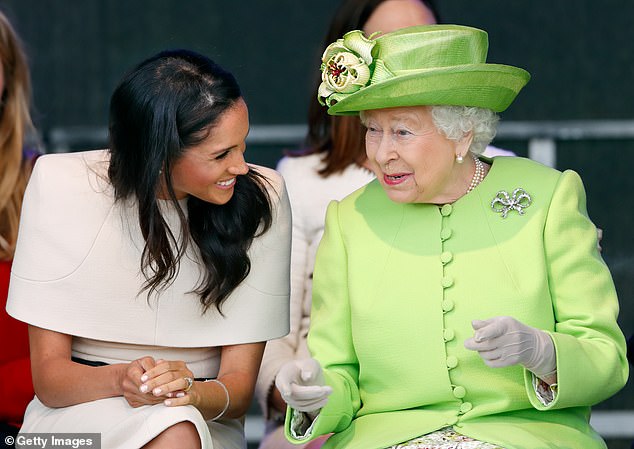
The Queen liked Meghan and had high hopes for what the American actress might be able to achieve with Harry for the youth of the Commonwealth
The Queen Mother later blamed the couple for her husband’s early death —caused, she felt, by the stress of taking on the role of King, for which he had been both unprepared and temperamentally unsuited. She never forgave the Duchess, whom she cast as a wicked enchantress.
From the start of Edward’s affair with Wallis — then still married — he had been infatuated with her to the point that he soon began to neglect his royal duties. Once, when he asked Wallis to light a cigarette for him, she replied: ‘Only if you ask properly’ — at which point he got down on his knees and begged like a dog.
Later, after their marriage, Wallis had happily accompanied the Duke of Windsor in 1937 on a visit to Nazi Germany, during which they met Hitler and were both photographed giving the Nazi salute.
As one who had lived through this tumultuous period of royal history, and been directly affected by it, Queen Elizabeth II was perfectly aware what Philip meant when he drew parallels between Meghan and Wallis. Indeed, much later, she would remark in her clipped way that perhaps Harry had been ‘too in love’ with the American actress.
As for Prince Philip, he never appeared to change his mind about Meghan. From the moment he detected her apparent similarity to Wallis, he referred to her as DoW (short for Duchess of Windsor).
Queen Elizabeth II never voiced her true opinion about Harry’s wife except to her very closest confidantes, such as Lady Elizabeth Anson, or Liza as she was known to her friends. A cousin of the Queen, she used to speak on the telephone to the monarch on a daily basis.
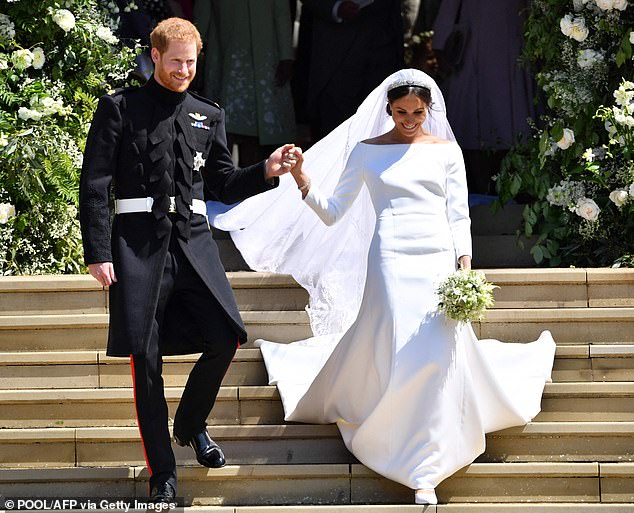
The Queen had made only one remark to her confidantes about Meghan and Harry’s wedding, which was that the bride’s Givenchy wedding gown (pictured) was ‘too white’ for a divorcee
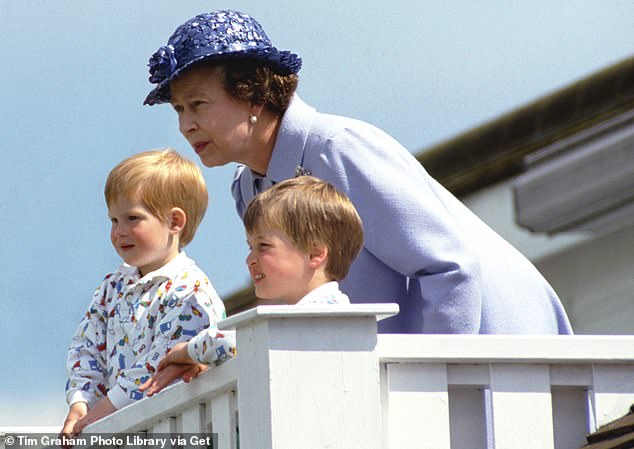
The Queen with a young Prince Harry (left) and William in Windsor, June 1987
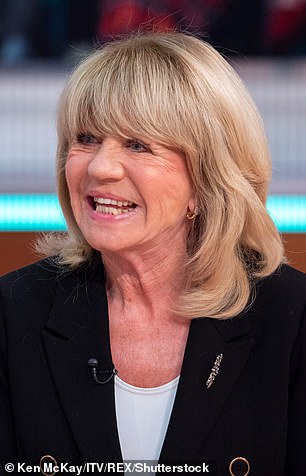
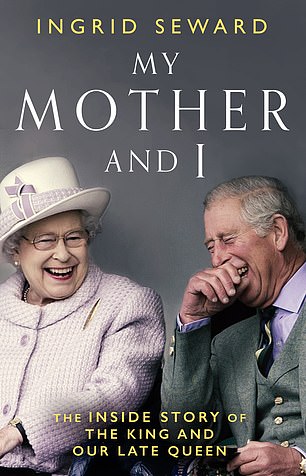
Majesty magazine editor Ingrid Seward (left) reveals all in a new book about the late Queen and the King, My Mother And I (right)
In the monarch’s view, it was not appropriate for a divorcee getting remarried in church to look quite so flamboyantly virginal.
Nor was the Queen comfortable with the Prince of Wales’s decision to stand in for Meghan’s father, Thomas Markle, and walk her down the aisle. She was also concerned about 96-year-old Prince Philip’s decision to hobble down the aisle without a stick, despite having had a hip replacement just five weeks before.
Then there was the service itself. Like many others in the congregation, she was startled by the impassioned outpourings of the American Archbishop Michael Curry, who spoke for more than 14 minutes. Both the Queen and Prince Philip, who hate long sermons, were desperate for him to finish. They must also have been aware that some of those around them were stifling their laughter.
One can only speculate about what they thought when Curry, who admitted he didn’t know either Harry or Meghan, later said he’d felt the presence of the slaves from whom he was descended in the chapel, which he felt to be a ‘sign of hope’.
According to Lady Elizabeth, the Queen was dismayed by Harry’s high-handed attitude both before and after the wedding, and their relationship was ‘quite badly damaged by it all’. It was even more damaged when Harry decided to give up being a working royal and leave the country — a decision, said Lady Elizabeth, that the Queen never truly understood. Then came the couple’s infamous interview with Oprah Winfrey, in which Harry said his father was ‘trapped’ and heavily implied that the Royal Family were racist.
The Queen was upset by his attitude, said Lady Elizabeth. However much she loved Harry — and she did — she couldn’t condone the way he was speaking about the institution of the monarchy she’d spent 70 years preserving.
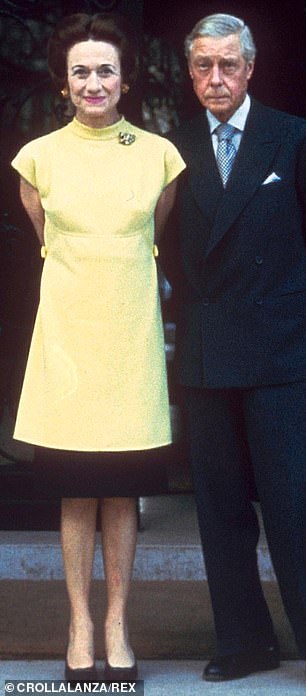
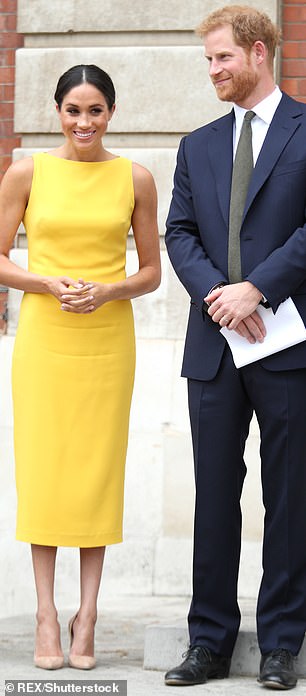
Prince Philip said it was uncanny how much Meghan (pictured right with Prince Harry in 2018) reminded him of the Duchess of Windsor Wallis Simpson (pictured with Edward in 1966)
At that point the Queen decided there was no longer any point in worrying about Harry as he wasn’t going to take notice of anyone but his wife. Whether she ever came to view Meghan as a 21st century Wallis Simpson will probably never be known. It may have crossed her mind, however, that Philip wasn’t that far off the mark.
In Prince Harry’s memoir Spare, his ghostwriter J. R. Moehringer paints a graphic picture of the Prince’s feelings about being second in line to the throne: ‘I was the shadow, the support, the Plan B. I was brought into the world in case something happened to Willy. I was summoned to provide back-up, distraction, diversion and, if necessary, a spare part. Kidney, perhaps. Blood transfusion. Speck of bone marrow.’
That is completely untrue, but it was how Harry chose to see himself, and he has allowed this perception to dominate his life — to the extent that he has now made a career out of it.
Choosing to be seen as a victim, he has tried to wreak vengeance on his family and the Press for all the slights he believes he’s suffered. And much of his ire has been directed at his elder brother. The roots lie in childhood. For a long time, Princess Diana called Harry ‘her little baby’; for his part, he didn’t want to share his mother with William, who is two years his senior.
Perhaps as a consequence, Harry always felt the need to compete in everything with his brother. It didn’t help that William was notably more successful at school than his brother. Diana’s friend and alternative healer Simone Simmons was called in to give healing to Harry — partly for headaches but also because he was struggling with dyslexia.
Diana was concerned everyone was going to think her younger boy was ‘thick’ as he didn’t have any thirst for knowledge and was never interested in sitting down with a book.
The relationship between the two brothers continued to be fraught with rivalry. Years later, when he was about to get married, Harry went to see the Queen to ask permission to keep his beard on his wedding day.
The accepted rule is ‘no beards when wearing military dress uniform’. Despite this, the Queen reluctantly agreed, as it seemed so important to her grandson.
But when William found out, he was furious: annoyed that Harry had gone to the Queen, annoyed she had given him her clearance and annoyed at what he saw as Harry’s one-upmanship.
For his own wedding, William hadn’t been allowed to keep his beard or to wear the military outfit of his choice. He was the heir and had to do everything by the book. An argument between the brothers became so heated that at one point William actually ordered Harry to shave, ‘as the heir speaking to the spare’.
As the spare, Harry had always been allowed greater licence than his elder brother. He’d play the fool and get away with childish pranks such as standing behind visitors and pulling funny faces behind their backs.

Prince Philip never appeared to change his mind about Meghan. From the moment he detected her apparent similarity to Wallis, he referred to her as DoW. Pictured: Philip (left) attends a Christmas Day service with the royals including Harry and Meghan (right) in 2017
He showed an early talent for mimicry that took scant account of the importance of the person he was imitating — antics that amused both Charles and Diana. Later events suggest, however, that a bit more early discipline might have been helpful.
Had Charles been firmer with Harry — and, to some extent, William — in their formative years, they might not have caused him so much worry.
In Harry’s case, the upshot seems to be an unwillingness to take responsibility for his own actions, and a tendency to blame others when things don’t work out the way he wants. He certainly always knew where he stood in the royal pecking order: at the age of nine he turned to his brother and declared: ‘You’re going to be King; it doesn’t matter what I do.’
Put another way, he saw this as a licence to do almost whatever he wanted.
William, for his part, was increasingly weighed down by the future unfolding before him. He became withdrawn and his head drooped in public.
Just the sight of a camera would make him feel uncomfortable.
As his introspection became more pronounced, he grew closer to Diana, while Harry was discovering he had more in common with his father. There was no marked favouritism involved: both Charles and Diana were careful to dispense their affection to their sons equally.
Harry became fascinated with guns and all things military, pestering his father into taking him to Salisbury Plain to review the Gurkhas stationed there. They travelled by helicopter, both of them wearing combat fatigues, and afterwards Harry declared he wanted to be a soldier when he grew up.
Father and son also spent many happy hours together when Harry was learning about nature and plants. ‘Plants have feelings too,’ Charles explained to him, describing how he talked to his plants to encourage their growth.
Teaching Harry and William to enjoy the things he did was very much Charles’s way of showing them love, rather than smothering them with hugs and kisses. Sadly, Harry doesn’t accept this: he has said that he ‘bombards’ his own children with the love he feels he never received from his father.
William, meanwhile, was quite content to spend the afternoons home from school curled up on the sofa in Diana’s Highgrove sitting room. Explaining her sons’ different characters, Diana once told me: ‘William is very sensitive and Harry is very lively.’
She added that ‘William wants me to be there for him.’
She was wrong, however, about certain traits in Harry’s character. Since marrying Meghan and moving to California, it’s become clear he has inherited some of his father’s more unattractive characteristics — such as what Prince Charles’s former Press Secretary Mark Bolland called ‘his self-pitying approach to life’.
The Queen had always thought Charles and Diana’s children were unruly little boys, and she was right. On one occasion they climbed onto the grand piano at Sandringham and Harry knocked a vase of flowers onto the floor, where it broke.
Nanny was summoned to organise clearing the mess, but the Queen got to hear about the boys’ antics and was not pleased. It may have been holiday time, but this was still a court bound by rules and conventions that had changed little since Victorian times.
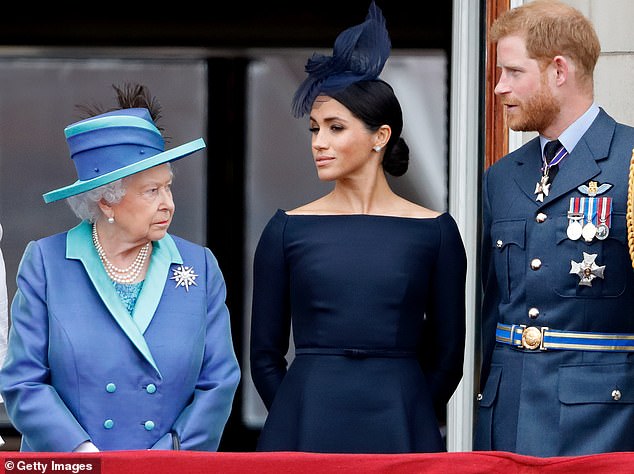
Queen Elizabeth II never voiced her true opinion about Harry’s wife except to her very closest confidantes, such as Lady Elizabeth Anson, or Liza as she was known to her friends. Pictured together on the Buckingham Palace balcony in 2018
One of the first things William’s nanny Barbara Barnes had been required to teach him and his brother was to bow to the Queen and the Queen Mother. This mark of royal respect to two anointed queens was rigorously enforced, as one of the long-serving members of the royal staff recalled: ‘When they came to visit, the boys would wait by the door. When they entered, the boys bowed and then kissed them on the cheek and gave them a hug. It sounds a bit strange but it was not uncomfortable. It was so natural the boys didn’t think anything of it.’
The Queen always took a close interest in her grandchildren’s welfare, particularly after their parents’ marriage became riven with acrimony.
During this period, William became noticeably petulant and it seemed to the Queen’s staff that he’d inherited the worst characteristics of both his parents.
They may not have known that the boy sometimes heard his parents fighting and witnessed his mother’s tearful outbursts. Harry, being two years younger, would be whisked off by nannies and shielded from any unpleasantness between his parents.
After Charles and Diana separated, the Queen felt her son was doing the best he could for his own sons.
In truth, however, Charles never had much chance to develop a meaningful relationship with his growing boys as Diana curtailed his time with them. Whenever he wanted to have them with him for the weekend, she thought of an excuse to keep them with her, usually at the last minute.
The Queen, well aware of this, worried about the damage the Princess was inflicting on the boys, especially William. But no one worried much about Harry as he was a happy, confident boy, completely at ease with himself.
As for William, the Queen managed to establish a special relationship with him when he was at Eton College and this has stood him in good stead. Over tea at Windsor, he began to understand the strength of the monarchy and learned from his grandmother what it would take to fulfil his future role.
The Queen particularly appreciated William’s ability to make Prince Philip laugh. Whenever they went duck flighting together (shooting ducks over still water), the boy always managed to prise his grandfather out of his cantankerous moods.
Philip would come home cheerful and, if not exactly full of bonhomie, was at least no longer grumpy — for which the Queen was always grateful.
My Mother And I by Ingrid Seward to be published by Simon & Schuster on February 15 at £25. © Ingrid Seward 2024. To order a copy for £21.25 (offer valid to 09/03/24; UK P&P free on orders over £25) go to mailshop.co.uk/books or call 020 3176 2937.



